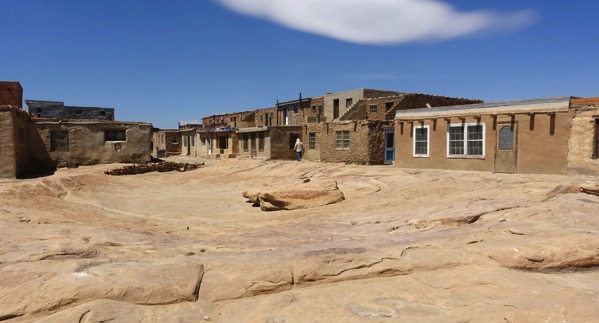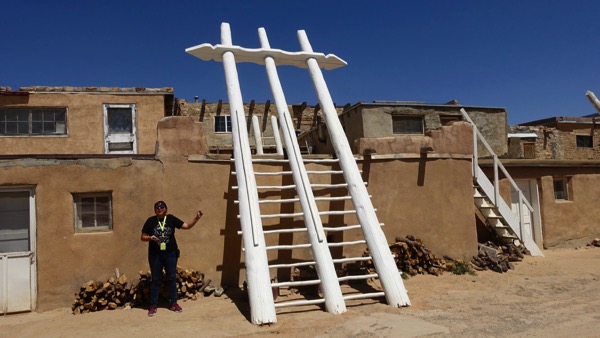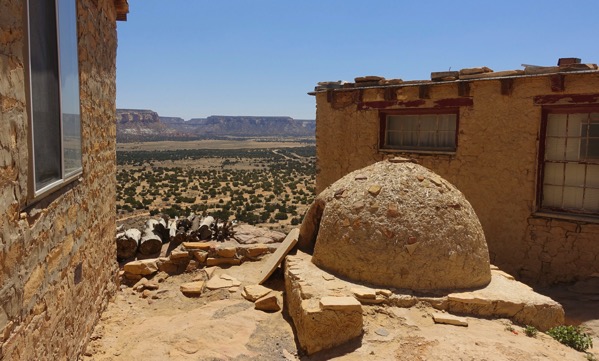
We visited an ancient pueblo (village) atop a mesa today…still without electricity and with perhaps fifteen year-round, permanent residents. This is the view down; I have no good shots of the view up at the plateau-top architecture. This is considered the winter housing, roughly, of the people. In summer, they mostly lived down by their fields on the flats below.

There are no flowing water sources atop the mesa, and this was an open cistern the people used anciently, and empty today. Residents now customarily drive water in barrels and plastic containers up the steep, paved road to their homes. Part of the road is visible in the first photo.

These are among the documented oldest walls/homes in the pueblo. Using a cannon and other means, Spanish thugs destroyed much of the pueblo in 1599, so the many buildings standing in the 16th C were more than decimated.

This is a double ladder to the roof of a kiva that post-dates the Spanish destruction. The Spanish were keen to convert the Acoma to Christianity and get them to abandon their pagan practices. But the Acoma people disguised their previously circular kiva ceremonial rooms by making them rectangular like the house rooms. The second ladder behind the double one descends into the kiva. Except for a few special events, only men entered the kivas. Our guide, the young woman shown, did not say if that is still true, but I’m guessing it is. The Acoma are matriarchal, and the women own the homes, fields, crops, and most other household items.

This humped structure is a baking oven, used for food not pottery. These days, I’m guessing they are mostly only used at special times of the year, and not on a weekly/monthly basis.

That snow-dusted mountain in the far distance is Mount Taylor, a sacred place to the native peoples of this region. The beams supporting the roof of the early 17th-C church atop the mesa were cut on the mountain and brought by the men of Acoma under order and direction of a Spanish priest. The Spanish did not permit four special beams used in the altar to touch the ground during the whole process of carrying them BY HAND (not using animal labor) to the church. What high-handedness.

Okay, switch gears. This is the walkway to the casita the Guru and I are staying in, an independent outbuilding of the main house, where the rest of the party are staying. The whole place is lovely, wonderful, and relaxing. Except maybe this stepped path for The Foot—no, really, it’s good exercise.

Here’s the view from the living room area of our casita. See? Relaxing.

We went to a nearby restaurant for our evening meal…boy, are we lucky; the food is outstanding; I mean, it could not be better. Oh, yum. This is a version of chile relleno I’ve never had, with a splayed roasted chile stuffed with a mixture of corn kernels, mushrooms, and pine nuts, with a bit of cheese on top. Soooooo tasty. I expect we’ll be eating here again, perhaps as soon as tomorrow. We shall see.
16 April 2018 at 9:12 am
Pooh says:
The photo of the double ladder appears to move, at least when only the top part is visible. I was reading the text above it, and it looked like the ladder was sliding outwards.